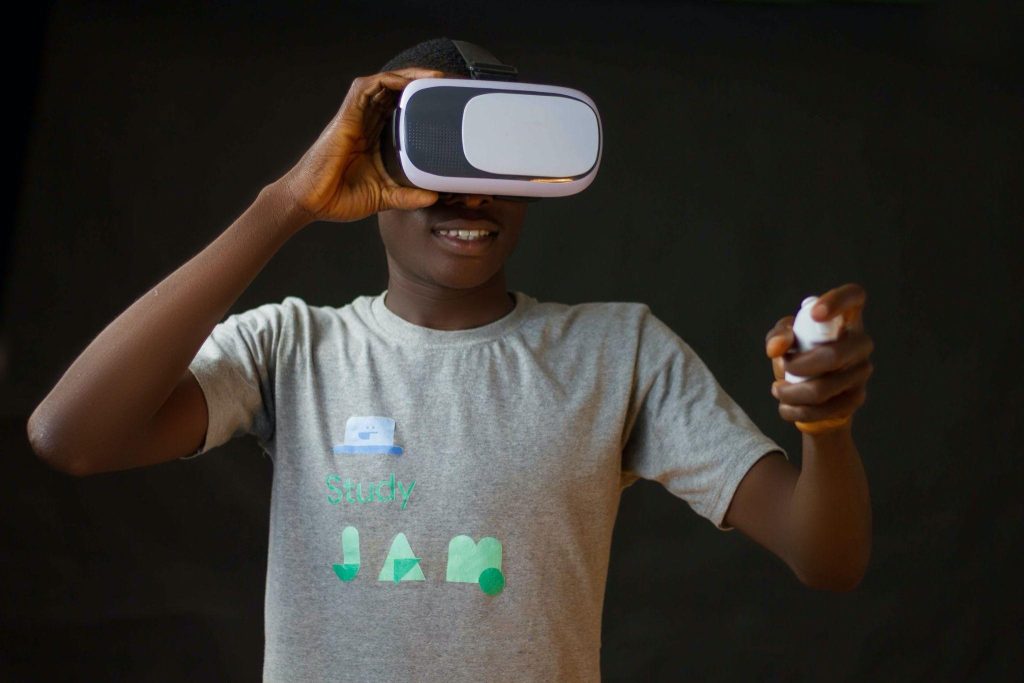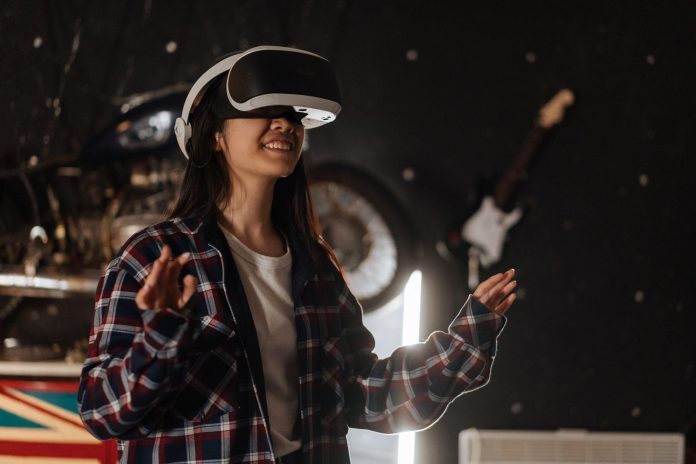Virtual reality (VR) has brought a massive change in video games. This idea began when popular games like Grand Theft Auto: Vice City and Counter-Strike drew much attention. Seeing how much people loved these games, the creators began to imagine a new and exciting future for gaming.
They dreamt of virtual reality gaming, a new way to play that combines the best technology and video game art. Using high-quality visuals and special VR equipment, it lets players feel inside a 3D world right from home. This lets them enter the game’s world and live the adventure themselves.
VR gaming is unique because it copies our real-world actions in the game. If a player jumps or crouches in real life, their character in the game does the same thing immediately. Also, VR games let people meet and interact with other players as their game characters.
Factors Driving the Revolution in Online Gaming
The technological landscape of online gaming has evolved dramatically over the years. This evolution has altered the gaming experience and reshaped the gaming industry.
The Growth of Processing Power and Graphical Capabilities
The most transformative shift in online gaming can be attributed to the exponential increase in processing power and graphics capabilities. As the bedrock of online gaming, advancements in these two areas have spurred a digital revolution.
The Evolution of Gaming Consoles and PCs
Decades ago, gaming consoles and PCs were constrained by limited processing power and graphical abilities. Today’s gaming systems, however, are high-powered machines that deliver breathtakingly realistic graphics, seamless gameplay, and real-time responsiveness. Gaming consoles like the PlayStation 5 and the Xbox Series X and high-performance PCs equipped with advanced graphic cards like Nvidia’s RTX series stand testament to this revolution.
These machines can render hyper-realistic environments, detailed character models, and smooth animations that were inconceivable in the early days of gaming.
Significant Games That Have Raised the Bar in Graphics
Notable games such as ‘The Witcher 3: Wild Hunt’, ‘Red Dead Redemption 2’, and ‘The Last of Us Part II’ exemplify the power of modern graphics. These games have transcended previous graphical limits, providing players with immersive environments that blur the line between virtual and reality.
The Rise of Mobile Gaming
The democratization of gaming, brought about by the advent of smartphones, has further revolutionized the online gaming landscape.
The Democratization of Gaming through Mobile Devices
This broad access to games has also helped to make gaming a normal part of everyday life for people worldwide. It’s no longer just a hobby for a small group of enthusiasts. Instead, millions worldwide are now playing games on their phones and tablets.
In addition, the best online casinos have launched their mobile apps, making it easier for people to enjoy their favorite games whenever and wherever they want. Whether waiting for a bus or relaxing at home, fans can easily log in and start playing.
The growth of mobile gaming has been truly staggering. According to Statista, in 2022, nearly three-quarters of all digital gaming revenue worldwide came from mobile gaming. That’s a clear sign of how popular mobile gaming has become.
Increased Player Base
Mobile gaming has broadened the player base significantly. Games like Pokémon Go, Among Us, and PUBG Mobile cater to a diverse audience, from casual gamers looking for a quick game on their commute to hardcore gamers seeking intense multiplayer action. This widespread appeal has led to an unprecedented expansion of the global gaming community.
The Development of VR and AR Technologies
The emergence of Virtual Reality (VR) and Augmented Reality (AR) technologies has added a new dimension to online gaming, providing immersive experiences unlike before.
VR and AR Technologies in Gaming
VR immerses players in an entirely virtual world, while AR overlays virtual elements onto the real world. These technologies have opened up new avenues for gameplay and narrative, pushing the boundaries of what is possible in a game.
Popular VR games such as Half-Life: Alyx and AR games like Pokémon: Go showcase the potential of these technologies in creating unique and immersive experiences.
Impact of VR and AR on Gaming Experiences
The impact of VR and AR on gaming is profound. These technologies enhance player engagement and retention by providing a higher level of immersion. Moreover, they have spurred innovation in game design, with developers exploring new ways to leverage these technologies for more interactive and realistic gameplay.
 The Expansion of Multiplayer Gaming and The Socialization of Gaming
The Expansion of Multiplayer Gaming and The Socialization of Gaming
The social aspect of online gaming, enhanced by the proliferation of multiplayer games, has added another layer of complexity to this evolving landscape.
The Progression of Multiplayer Gaming
Multiplayer gaming has come a long way, from simple two-player formats to today’s massively multiplayer online games (MMOs). Improved internet and cloud-based gaming have allowed millions of players worldwide to connect in real time.
The growth of eSports has added a competitive edge to multiplayer gaming. Tournaments like the FIFAe World Cup and Tekken World Tour have taken multiplayer gaming to a professional level, attracting gamers globally. These developments show the fast-paced evolution of multiplayer gaming, making the future look even more exciting.
The Impact of Social Features on Gaming
Social features like chat functionality, in-game collaborations, and social media integrations have fundamentally changed the gaming experience. They have transformed games into social platforms, fostering global communities beyond the games themselves. These communities, formed around shared gaming experiences, further enrich the online gaming landscape.
Enhancing Global Connectivity in Online Gaming
Technological advances have played a pivotal role in creating a globally connected online gaming community. Internet accessibility and improved networking technologies have enabled gamers worldwide to engage in a shared virtual environment.
This paradigm shift is fuelled by cloud-based gaming platforms, offering flexible gaming access anytime, anywhere.
The transformation has far-reaching implications, turning games from individual entertainment into dynamic social platforms and fostering global connectivity. Whether collaborating on missions, participating in international eSports tournaments, or interacting through in-game chats, technology has facilitated a shared gaming experience on an unprecedented scale.
This trend is a testament to the ongoing technological revolution shaping the online gaming industry, heralding an increasingly interconnected future for the global gaming community.
Final Thoughts
The tech changes aren’t done yet and will keep making online gaming even better. As we step into the future, our game will change uniquely, going beyond what we think is possible now. This will create a new kind of fun. The online gaming industry, helped by these tech improvements, is ready to grow and involve more people like never before.
Other Technical Reviews:- Reviews













